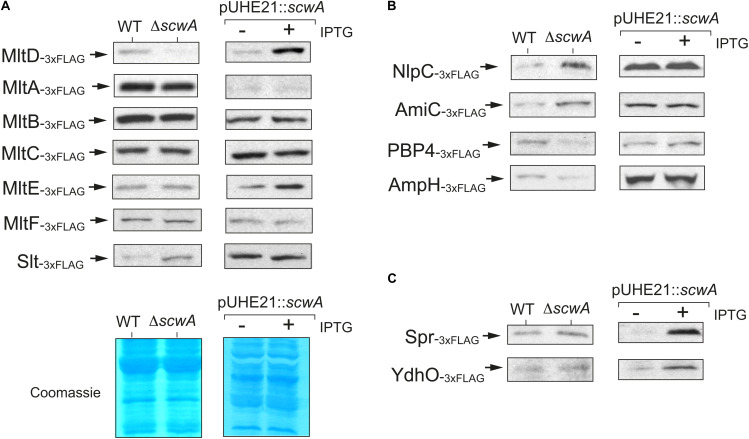FIGURE 5.
S. Typhimurium ScwA controls the levels of the murein lytic transglycosylase (LT) MltD and a few other PG hydrolases. (A) Immunoblot assays with anti-FLAG antibody of whole cell lysates showing positive correlation between ScwA and MltD levels, these later decreasing in the absence of ScwA but increasing in response to the overproduction of ScwA from plasmid pUHE21. Among the other LTs tested, MltA, MltB, MltC, MltE (EmtA), MltF or Slt, only a minor effect is seen in the case of Slt. The comparison between wild type and ΔscwA strains (left columns) was performed in stationary phase cultures (OD600∼2.5) whereas production of ScwA from the pUHE21 plasmid was induced in exponential phase cultures (OD600∼0.2–0.3) with 1 mM IPTG for 40 min. The lower image shows representative Coomassie-stained gels demonstrating proper samples adjustment in the two types of assays designed to test the effect due to either the absence or overproduction of ScwA. (B) Altered levels of NlpC, AmiC, PBP4, and AmpH observed in the ΔscwA mutant. None of these proteins change, however, in their relative amounts in response to ScwA overproduction (right columns). Shown are anti-FLAG immunoblots of whole cell lysates. The left (wt and ΔscwA strains) and right (–/+ induction of ScwA expression with IPTG) samples correspond to the same conditions as described in panel A (stationary and exponential phase, respectively). (C) Increased levels of the D,D-endopeptidases Spr (MepS) and YdhO (MepH) in response to ScwA overproduction. Unlike MltD, these two enzymes remain unaltered when comparing wild type and ΔscwA strains. The respective 3×FLAG-tagged strains used in these assays are described in Supplementary Table 1.

